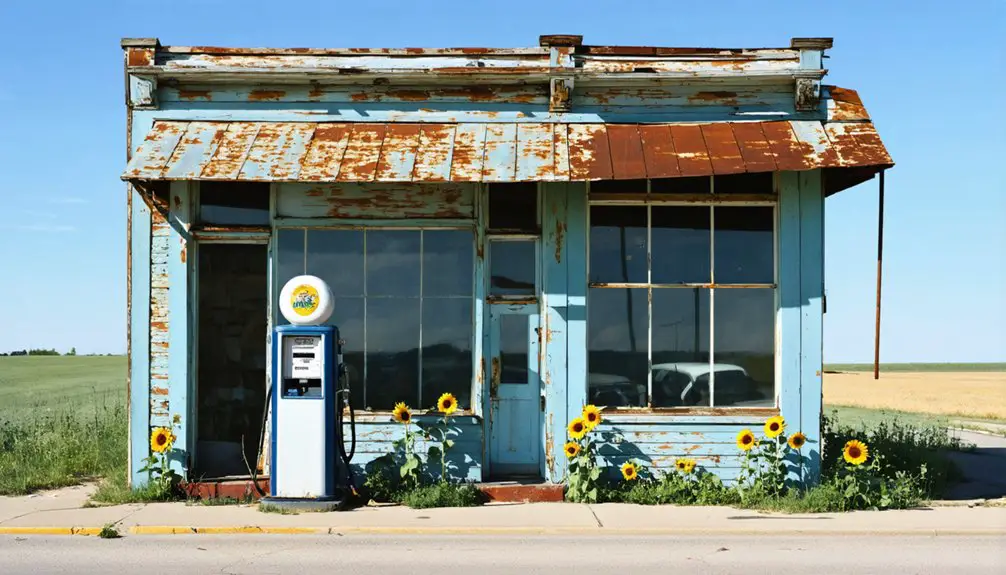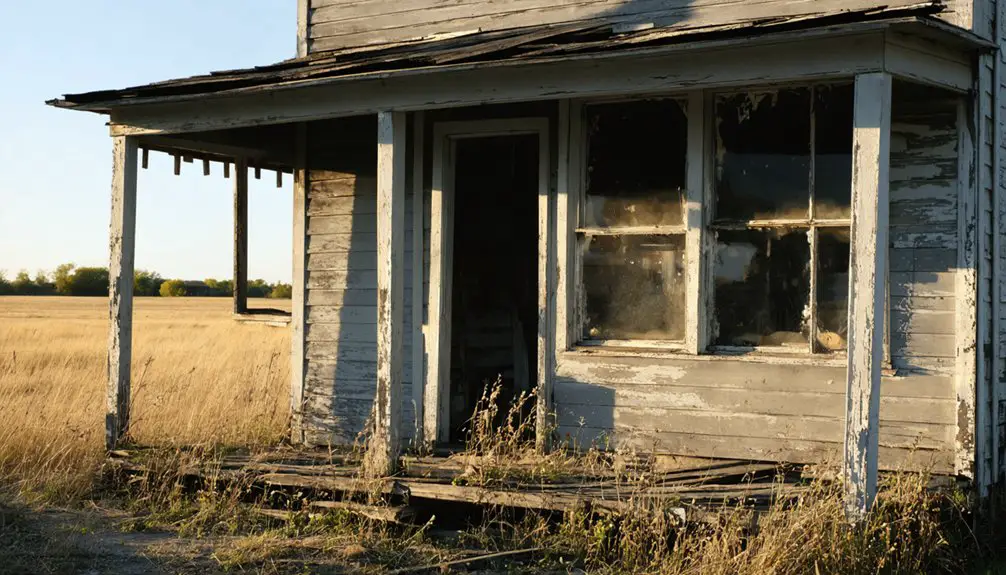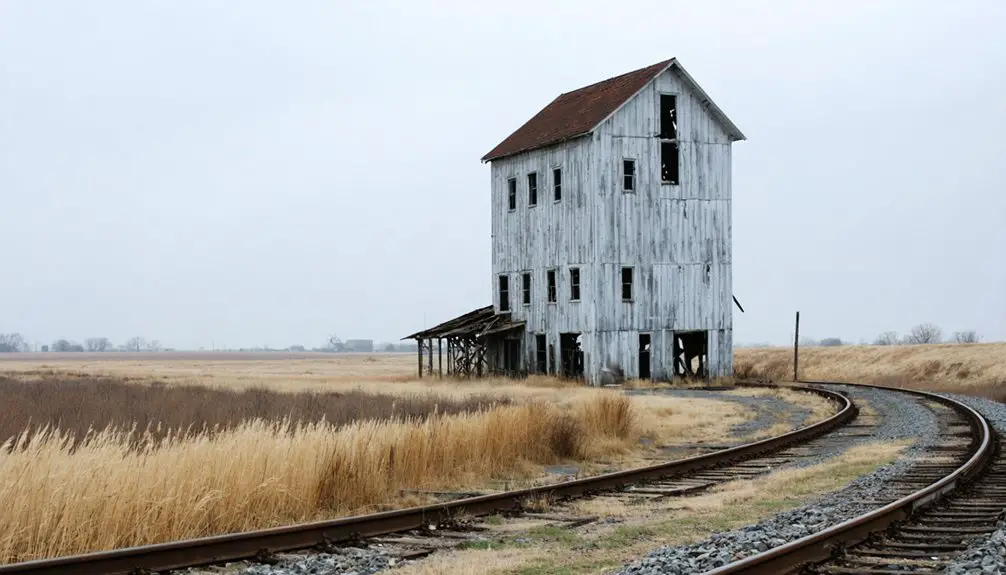You’ll find Byers, Kansas five miles north of the Oklahoma border, where J.M. Byers established a frontier trading post in 1885. The settlement quickly grew to 300 residents, featuring multiple grocery stores, a blacksmith shop, and a post office that operated until 2004. The community’s social fabric was woven through large family gatherings, church events, and communal rabbit hunts. This ghost town’s rich history reveals fascinating stories of pioneer resilience and frontier innovation.
Key Takeaways
- Byers, Kansas was established in 1885 by J.M. Byers, initially thriving with 300 settlers within four months of its founding.
- The town’s economic center included a store, blacksmith shop, multiple grocery stores, and a flour mill during its peak.
- Located five miles north of the Kansas-Oklahoma border, Byers served as a crucial trading post for regional commerce.
- The post office closure in 2004 marked a significant turning point toward ghost town status after serving the community since 1915.
- Population decline mirrored typical Kansas ghost town patterns, with economic hardships during the Great Depression contributing to its abandonment.
The Birth of a Pioneer Trading Post
In the summer of 1885, J.M. Byers established an essential trading post that would showcase pioneer resilience in south Meade County, Kansas.
You’ll find his legacy in the settlement he founded near Nirwana, starting with a store and blacksmith shop on his farmland. Within months, trading innovations emerged as multiple grocery stores opened, and plans for a dry goods store took shape. Like the early European settler techniques seen in many frontier towns, the buildings were constructed with great care and skill.
The post office, a significant link to the outside world, served the community for two decades, though it changed locations three times.
As a strategic hub on the Jones and Plummer trail, Byers quickly attracted 300 settlers who built sod houses and formed a bustling community. When food became scarce, resourceful residents gathered native edible plants for sustenance.
You’ll appreciate how this trading post’s position, just five miles north of the Kansas-Oklahoma border, made it indispensable for regional commerce.
Life in Early Byers Settlement
While pioneers sought to establish a foothold in Meade County’s challenging terrain, life in early Byers settlement tested their resilience against nature’s harsh realities.
You’d find families living in combined-purpose buildings near J.M. Byers’ store and blacksmith shop, where trading activities centered around the essential Jones & Plummer Trail.
Pioneer experiences were shaped by constant challenges – you’d battle swarms of mosquitoes while watching the wild, shifting sand hills covered in buck sage and yucca.
Your daily survival meant coping with water scarcity, except near the life-giving Cimarron River.
Like the Kansa settlement patterns of the 1600s, residents clustered near water sources for survival.
Settlement resilience emerged through community gatherings and mutual support, though fears of Indian raids kept settlers vigilant.
Despite organized town planning efforts and attempts to attract investment, Byers’ harsh environment ultimately limited its growth and permanence.
Much like Columbia’s settlers who faced destructive floods repeatedly, Byers residents contended with natural disasters that threatened their community’s stability.
Economic Forces and Town Migrations
Byers’ initial economic foundation emerged from J.M. Byers’ trading post and blacksmith shop, which served travelers along the Jones and Plummer trail while attracting early settlers to the area.
You’ll find that population movements in Byers followed typical patterns of Kansas ghost towns, with rapid early growth followed by gradual decline as residents sought better opportunities in more established cities. Similar to the mining town decline seen in Midway and Lichfield, only trees and empty land remain where Byers once flourished. The hardships faced by the town mirrored those experienced during the Great Depression era, which devastated many similar Kansas communities.
The town’s infrastructure development faced significant challenges, including intermittent post office service and lack of railroad access, which ultimately limited its potential for sustained economic growth.
Trading Post Foundations
Trading posts served as the economic foundation and catalyst for settlement in early Kansas Territory, with the Chouteau Trading Post establishing a crucial presence in 1825 under Cyprian Chouteau’s Indian trading license.
You’ll find the trading post significance reflected in its evolution from a hub of indigenous commerce to the first permanent white settlement in Linn County.
Located strategically along the Marais des Cygnes River, the post facilitated essential trade with Osage Indians while pack horses transported goods through dense woodlands.
Much like the historic trading posts, Byers maintained its vitality through women in government during the 1960s, when female leaders spearheaded town improvements.
As settlement increased, the trading post’s identity shifted from Chouteau Trading Post to Blooming Grove in 1857, and finally to Trading Post in 1880.
The establishment fostered economic growth, spawning multiple general stores, a drug store, and a flour mill that expanded the area’s commercial reach beyond basic trading.
The Montgomery Town Company platted the official townsite in 1865, further solidifying the settlement’s transformation from trading post to organized community.
Population Movement Patterns
Despite initial rapid settlement that drew nearly 300 pioneers in 1885, Byers experienced a dramatic population decline that transformed it from a bustling frontier town to a sparse community of just 37 residents by 2024.
Key migration trends and demographic shifts have shaped Byers’ destiny:
- The median age of 60 years reflects significant youth out-migration.
- Owner-occupied households average just 1.67 persons, indicating limited family growth.
- The closure of essential services, including the post office in 2004, accelerated population loss.
- Economic stagnation, with household incomes around $48,800, pushed residents toward urban opportunities.
Located in Pratt County, Kansas, Byers covers a small area of less than one square mile, limiting its potential for significant expansion.
For clarity in historical records, direct links to specific Byers locations help distinguish this ghost town from other places sharing the same name.
You’ll find today’s Byers dramatically different from its pioneer origins, as limited economic diversification and declining infrastructure continue driving the town’s transformation into a near ghost town status.
Infrastructure Development Challenges
When examining infrastructure development in frontier Kansas, multiple economic forces conspired against Byers’ sustainability.
You’ll find that limited economic incentives and weak commercial activity made infrastructure investment nearly impossible. The town’s small population, centered around JM Byers’ store and blacksmith shop, couldn’t generate sufficient capital for essential development.
The absence of railroads proved particularly devastating to Byers’ economic sustainability. Without rail access, the town struggled to compete with better-connected settlements that attracted both people and resources.
You can trace how nearby towns like Nirwana drew away settlers and businesses, while Byers’ isolation from major transportation routes left it unable to develop vital infrastructure like improved roads, utilities, and telegraph services.
The town’s dependence on agriculture alone, without diversification into mining or other industries, ultimately sealed its fate.
Community Stories and Social Fabric

As settlers flocked to Byers in 1885, they quickly wove together a vibrant social fabric that defined this Kansas frontier community.
You’d find bustling community gatherings centered around schools, churches, and lodges, where social networks thrived through shared experiences and mutual support.
- Large families of up to 25 members formed the backbone of Byers’ social structure.
- Local correspondent “Rose Bud” kept everyone connected through weekly newspaper reports.
- Rabbit hunts doubled as competitive social events and economic opportunities.
- Music, particularly church quartets, brought artistic expression to the prairie life.
The town’s spirit lived in the daily interactions of its people, from teachers boarding with local families to neighbors helping neighbors.
J.M. Byers’ store and blacksmith shop became more than businesses – they were gathering spots where community bonds strengthened.
The Rise and Fall of Postal Services
Since its establishment in 1915, the Byers post office served as an essential community hub that marked the town’s official recognition and facilitated important connections to the outside world.
You’ll find that postal service impacts extended far beyond mail delivery – the institution fostered economic growth by attracting businesses and supporting crucial communication channels for nearly 90 years.
Unlike the earlier Byers settlement near the state line, where the post office moved three times in two decades, this location maintained stable operations until 2004.
The communication evolution through postal services helped shape the town’s destiny, much like neighboring communities such as Hopewell.
When the post office finally closed in 2004, it marked a significant turning point in Byers’ decline toward ghost town status.
Legacy of a Lost Kansas Frontier Town

Though J.M. Byers couldn’t have known his frontier store and blacksmith shop would spark a short-lived but significant Kansas settlement, you’ll find his legacy deeply woven into ghost town stories that continue to captivate history enthusiasts.
Here’s what makes Byers’ story remarkable:
- Early settlers faced pioneer challenges with resilience, transforming harsh sod soil into farmland while building a community of 300 within four months.
- Families averaged 25 children, creating a vibrant social fabric centered around churches and schools.
- The community showcased frontier innovation through economic diversification, from farming to rabbit hunting.
- Dedicated educators like Nellie Byers fostered cross-county connections through the Waterford Joint District school.
Today, while Byers exists only in historical records, it represents the undying spirit of Kansas frontier towns.
Frequently Asked Questions
What Was the Average Land Price per Acre in Byers During 1885?
You’d find land values in 1885 ranged from $0.15 to $0.62 per acre, averaging around $0.40, due to challenging economic conditions, minimal development, and sparse population limiting demand.
Did Any Notable Crimes or Lawlessness Occur in Byers During Its Existence?
In 1915, law enforcement faced their biggest challenge when 24-year-old schoolteacher Nellie Byers was murdered. You’ll find this was the only notable violent incident, with suspects Archie Sweet and Clint Henson investigated.
What Happened to J.M. Byers After the Town’s Eventual Decline?
You’ll find J.M. Byers’ fate remains a mystery in historical records. His legacy vanished with the town’s decline, and despite thorough research, there’s no conclusive documentation about where he went afterward.
Were There Any Native American Interactions With the Byers Settlement?
Despite 300 settlers in 1885, you won’t find documented evidence of cultural exchanges between Byers and Native Americans. While the town sat near trade routes, specific interactions remain unknown in historical records.
Did Any Severe Weather Events Contribute to Byers’ Multiple Relocations?
You won’t find evidence that severe storms or tornado impacts caused Byers’ relocations. Historical records show the moves were likely due to economic and population shifts rather than weather events.
References
- https://www.visitoldmeadecounty.com/byers
- https://ulyssesnews.com/stories/the-ghost-of-the-cimarron
- http://kansasghosttowns.blogspot.com/2011/05/hopewell-kansas-pratt-county-ghost-town.html
- https://www.youtube.com/watch?v=PfThSLZOtqg
- https://www.youtube.com/watch?v=Td_gmiDMfI4
- https://history.denverlibrary.org/sites/history/files/RealPioneersColorado.pdf
- https://www.nps.gov/parkhistory/online_books/romo/buchholtz/chap2.htm
- https://usgenealogyresearch.atwebpages.com/Kansas/Rooks/pioneers_of_western_kansas.pdf
- https://pioneertradingpost.com/history.php
- https://www.youtube.com/watch?v=8MTb39F-4tc



